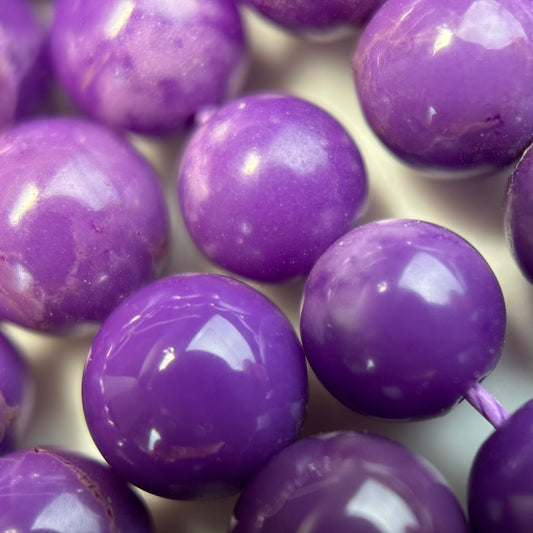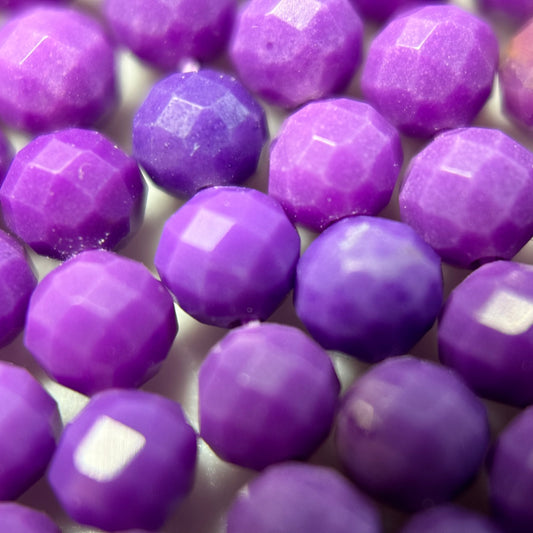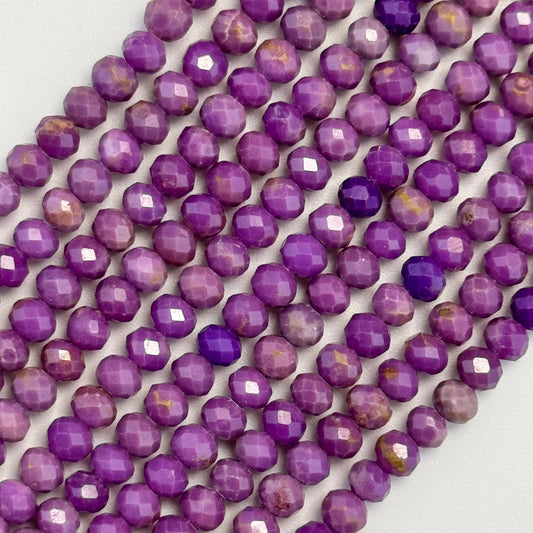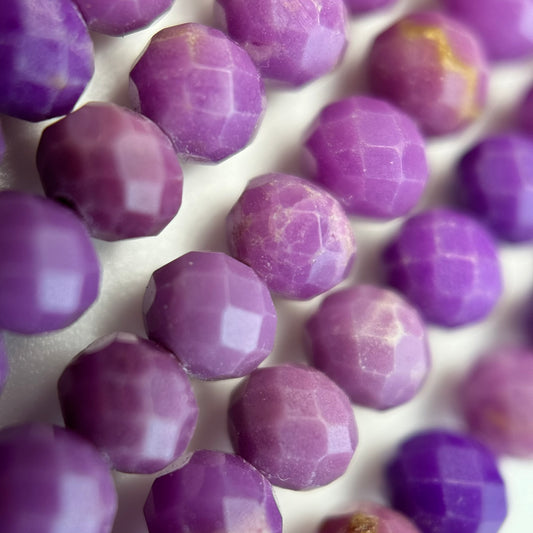Phosphosiderite Gemstone Beads
Introduction to Phosphosiderite Gemstone Beads
Phosphosiderite is a rare iron phosphate mineral known for its distinctive purple to pink coloration. This gemstone forms in phosphate-rich environments and displays unique visual properties that make it appealing to collectors and jewelry enthusiasts.
Notable Features
- Purple to pink coloration
- Phosphate mineral composition
- Rare and collectible
- Mohs hardness of 3.5-4
- Distinctive crystal habits
Chemical Composition and Structure
Phosphosiderite has the chemical formula FePO4·2H2O, making it a hydrated iron phosphate. It crystallizes in the monoclinic system.
Mineralogical Properties
- Chemical formula: FePO4·2H2O
- Crystal system: Monoclinic
- Specific gravity: 2.7-2.9
- Refractive index: 1.69-1.75
- Hydrated phosphate structure
Formation and Geological Settings
Phosphosiderite forms in phosphate-rich environments, typically in association with other phosphate minerals. It occurs in specific geological conditions.
Formation Environments
- Phosphate-rich pegmatites
- Oxidation zones of iron deposits
- Secondary mineral formation
- Specific pH conditions required
- Limited geological occurrence
Color Variations and Intensity
Phosphosiderite displays various shades of purple and pink, with color intensity varying between specimens. The coloration comes from iron content.
Color Characteristics
- Primary colors: Purple, pink, violet
- Color intensity varies
- Some specimens show color zoning
- Transparency ranges from transparent to translucent
- Iron content affects color
Crystal Habits and Forms
Phosphosiderite forms in various crystal habits including tabular, prismatic, and massive forms. Crystal quality affects its use in jewelry.
Crystal Forms
- Tabular crystals
- Prismatic habits
- Massive aggregates
- Botryoidal forms
- Crusts and coatings
Cutting and Lapidary Techniques
Phosphosiderite's relative softness requires careful cutting. The stone must be handled gently to prevent damage during processing.
Cutting Considerations
- Softness requires gentle handling
- Cabochon cuts most common
- Faceted cuts possible for quality material
- Bead drilling requires care
- Polish quality important
Hardness and Durability Properties
With a Mohs hardness of 3.5-4, Phosphosiderite is relatively soft and requires careful handling and protective settings.
Durability Factors
- Mohs hardness: 3.5-4 (soft)
- Susceptible to scratching
- Requires protective settings
- Careful storage important
- Not ideal for everyday wear
Geographic Sources and Rarity
Phosphosiderite occurs in limited locations worldwide, making it a rare and collectible material. Notable sources include various phosphate deposits.
Primary Sources
- Limited geographic distribution
- Phosphate pegmatite deposits
- Iron ore oxidation zones
- Collector-quality specimens rare
- Commercial availability limited
Care and Maintenance Practices
Phosphosiderite requires gentle care due to its softness. Proper cleaning and storage practices help maintain its appearance.
Care Guidelines
- Clean gently with soft cloth
- Avoid harsh chemicals
- Store separately to prevent scratching
- Protect from impacts
- Limit exposure to water
Jewelry Design Applications
Phosphosiderite beads create unique jewelry pieces, though their softness limits applications. They're often used in collector pieces or protective settings.
Design Uses
- Collector jewelry pieces
- Protective settings essential
- Showcase unique color
- Special occasion jewelry
- Display and collection pieces
Collectibility and Value Factors
Phosphosiderite's rarity and unique color contribute to its collectibility and value among mineral and gemstone enthusiasts.
Value Determinants
- Rarity increases value
- Color quality important
- Crystal quality affects value
- Size considerations
- Collector demand
Metaphysical Properties and Symbolism
Phosphosiderite holds significance in various metaphysical traditions, associated with emotional healing and spiritual growth.
Symbolic Meanings
- Emotional healing
- Spiritual growth
- Heart chakra connection
- Compassion and love
- Inner peace
Comparison with Similar Phosphate Minerals
Phosphosiderite may be confused with other phosphate minerals. Understanding its specific properties aids in identification.
Distinguishing Features
- Purple-pink color distinctive
- Iron phosphate composition
- Specific crystal habits
- Softness distinguishes from harder phosphates
- Limited occurrence
Frequently Asked Questions
What is the chemical composition and crystal structure of Phosphosiderite?
Phosphosiderite has the chemical formula FePO4·2H2O (iron phosphate dihydrate). It crystallizes in the monoclinic crystal system and is a secondary mineral formed through the alteration of primary iron phosphates. It's closely related to Strengite (which has the same structure but with aluminum instead of iron).
What causes the purple, pink, and violet coloration in Phosphosiderite beads?
The coloration in Phosphosiderite comes from the presence of iron (Fe3+) in the crystal structure. The purple, pink, and violet hues result from the electronic transitions of iron ions. The exact shade depends on the iron concentration, crystal size, and sometimes the presence of trace elements that can modify the color.
What is the Mohs hardness and durability of Phosphosiderite gemstone beads?
Phosphosiderite has a Mohs hardness of 3.5 to 4, making it relatively soft for jewelry use. This low hardness, combined with its brittle nature, means Phosphosiderite beads require careful handling and protective settings. They're better suited for occasional-wear or display jewelry rather than everyday pieces.
What is the specific gravity and how does it compare to other gemstones?
Phosphosiderite has a specific gravity ranging from 2.7 to 2.9, which is similar to many feldspar-based gemstones. This moderate density gives the beads a substantial feel without being excessively heavy. The specific gravity can help distinguish it from similar-looking materials.
What are the primary geological sources and formation conditions of Phosphosiderite?
Phosphosiderite forms as a secondary mineral in phosphate-rich environments, typically through the alteration of primary iron phosphates like Vivianite or through the oxidation of iron in phosphate deposits. Notable sources include Brazil, Germany, the United States (particularly New Hampshire), and some locations in Europe. It's relatively rare as a gemstone material.
How does Phosphosiderite differ from similar purple phosphate minerals?
Phosphosiderite (FePO4·2H2O) differs from Strengite (AlPO4·2H2O) in that it contains iron instead of aluminum, though they share the same crystal structure. It differs from other purple phosphates like Purpurite in its hydration state and crystal system. Phosphosiderite's dihydrate structure and monoclinic system help distinguish it from related minerals.
What optical properties distinguish Phosphosiderite from other purple gemstones?
Phosphosiderite has a refractive index of approximately 1.691-1.725, with birefringence of 0.034. It exhibits pleochroism, showing different shades of purple or pink when viewed from different angles. These optical properties, combined with its low hardness and specific gravity, help identify it and distinguish it from amethyst or other purple gemstones.
How does the secondary formation process affect Phosphosiderite's appearance?
As a secondary mineral, Phosphosiderite often forms as crusts, coatings, or replacement material, which can create interesting textures and patterns. The formation process can result in botryoidal (grape-like) surfaces, fibrous aggregates, or crystalline masses. These formation characteristics add to its visual appeal but can affect cutting and polishing.
What cutting and polishing challenges does Phosphosiderite present?
Phosphosiderite's low hardness and brittle nature make it challenging to cut and polish. The material requires careful handling to avoid chipping or fracturing. Polishing must be done gently with fine abrasives, and the material may show variations in hardness or texture depending on its formation conditions and any included material.
Can Phosphosiderite be enhanced or treated to improve its appearance?
Phosphosiderite is typically not treated, as treatments could damage the material or affect its color. However, some material may be stabilized if it's particularly fragile. Natural, untreated Phosphosiderite with good color and clarity is most valued. The material's rarity means treatments are less common than with more abundant gemstones.
What causes the variation in color intensity among Phosphosiderite beads?
Color intensity varies based on the iron content, crystal size, and formation conditions. Larger crystals or thicker material may show deeper colors, while thinner sections or material with less iron may appear lighter. The presence of other minerals or inclusions can also affect the perceived color intensity.
How should Phosphosiderite beads be cleaned and maintained?
Clean Phosphosiderite beads gently with a soft, dry cloth. Avoid water, chemicals, or cleaning solutions that could affect the phosphate structure or cause deterioration. Never use ultrasonic or steam cleaning. Store separately in a soft pouch to prevent scratching, and protect from impacts that could cause chipping or fracturing.
What makes Phosphosiderite beads unique among purple gemstone options?
Phosphosiderite is unique due to its phosphate composition, secondary formation process, and distinctive purple-pink coloration. Its rarity, combined with its interesting formation characteristics and the way it forms as alteration products, makes it a distinctive choice. However, its low hardness limits its practical use in jewelry.
How does Phosphosiderite's hydration state affect its stability?
Phosphosiderite's dihydrate structure (containing water molecules) means it can be sensitive to dehydration if exposed to heat or very dry conditions. This could potentially cause color changes or structural damage. The material should be protected from extreme temperatures and stored in conditions that maintain appropriate humidity levels.
What are the limitations of using Phosphosiderite in jewelry applications?
Phosphosiderite's low hardness (3.5-4), brittleness, sensitivity to water and chemicals, and relative rarity limit its use in jewelry. It's best suited for collector pieces, display jewelry, or occasional-wear items with protective settings. The material requires careful handling and is not recommended for rings or bracelets that experience heavy wear.





